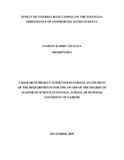| dc.description.abstract | The study sought to analyze the effect of interest rate capping on the financial performance of commercial banks in Kenya. The study employed descriptive research design. The target population was 43 Kenyan commercial banks. From the results of correlation analysis, the asset quality and financial performance of commercial banks in Kenya are negatively but significantly associated. Management efficiency and financial performance of commercial banks in Kenya was found to be positively and significantly associated. The correlation results found that bank size and financial performance of commercial banks in Kenya are positively and significantly associated. Finally, leverage had a negative and significant association with financial performance of commercial banks in Kenya. The model summary revealed that the independent variables: asset quality, management efficiency, bank size and leverage were found to be reliable indicators of financial performance of commercial banks in Kenya pre interest rate capping. Asset quality, management efficiency, bank size and leverage explain 47.1% of variation in the financial performance of commercial banks before interest rate capping. However, after interest rate capping asset quality, management efficiency, bank size and leverage explain 15.63% of variation in the financial performance of commercial banks. Regression results showed that asset quality has a negative and statistically significant relationship with financial performance of commercial banks, management efficiency has positive and statistically significant relationship with financial performance of commercial banks. Further, regression results indicated that the influence of asset quality, management efficiency, bank size and leverage on financial performance of commercial banks before interest rate capping was higher as compared to the influence after interest rate capping. This implies that interest rate capping leads to decline in financial performance of commercial banks. It was the conclusion of the paper that for asset quality to be sustained there should be prudent processing of loans which should meet the compliance of laid down rules by the regulator to minimize poor asset quality which affects both the soundness of the banking system but also the financial performance. The study further concludes that efficient banks will increase their competitiveness, scale much quicker, thereby ensuring a greater market share. In line with the findings highlighted, the study concluded that bank size has a positive and significant relationship with financial performance of commercial banks. It was also concluded that banks that have an appetite for high leverage stand a greater risk of going bankrupt if they fail to finance their debts, which may also curtail their ability to attract financing in the future. The study recommends that commercial banks commercial banks ought to diversify their product portfolio in order to increase revenue streams and supplement their income from their mainstay business. They should also maximize their resource allocation in order to improve their profitability. Product diversification should be on products that are not affected by the capping law. It also recommends that banks engage in volumisation strategy banks should mine their existing clients thoroughly by ensuring that clients are utilizing all products in the various suites. This full utilization of the various products in different suites will generate more fees for the banks. It is also recommended that commercial banks should also progressively phase out the brick and motor model they have been riding on over the years. The setting up of physical branches is a capital intensive process that drains up the banks’ capital which is much needed elsewhere. The study recommends that future research should introduce a moderating variable to the model. The moderator could be the regulatory environment. Future research should also consider having a regional perspective. It should especially focus on countries that have capping effected but on specific industries. | en_US |



